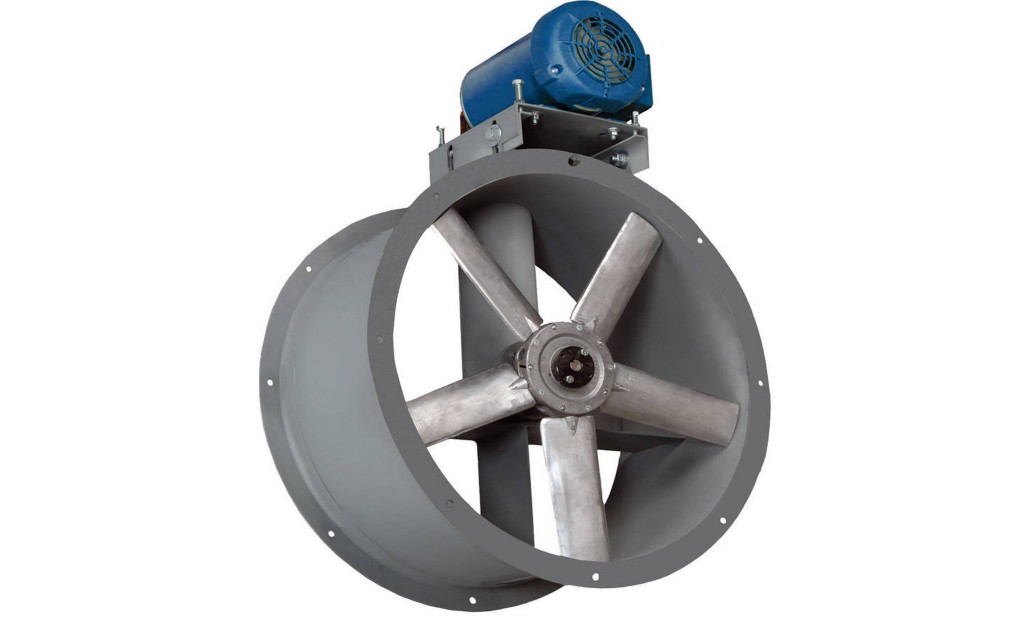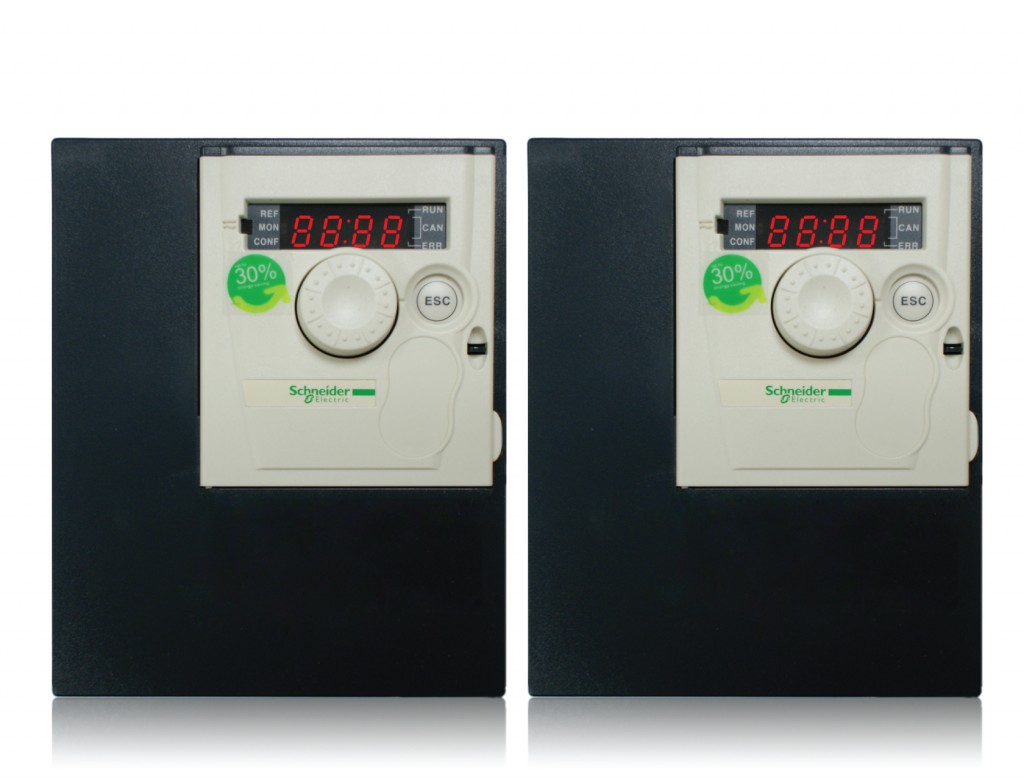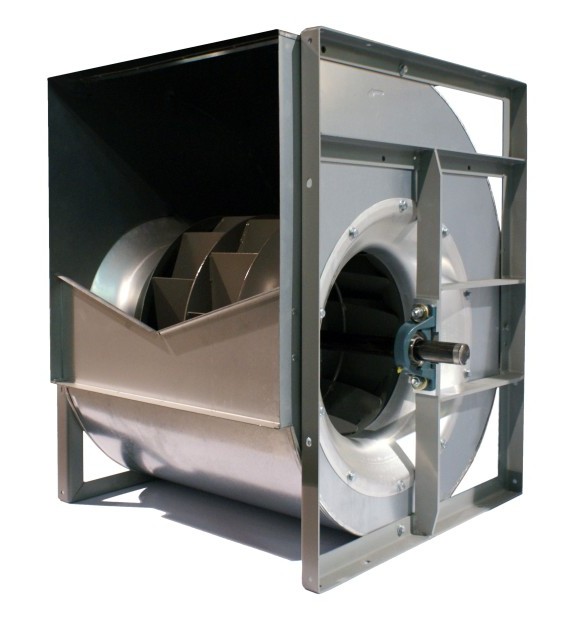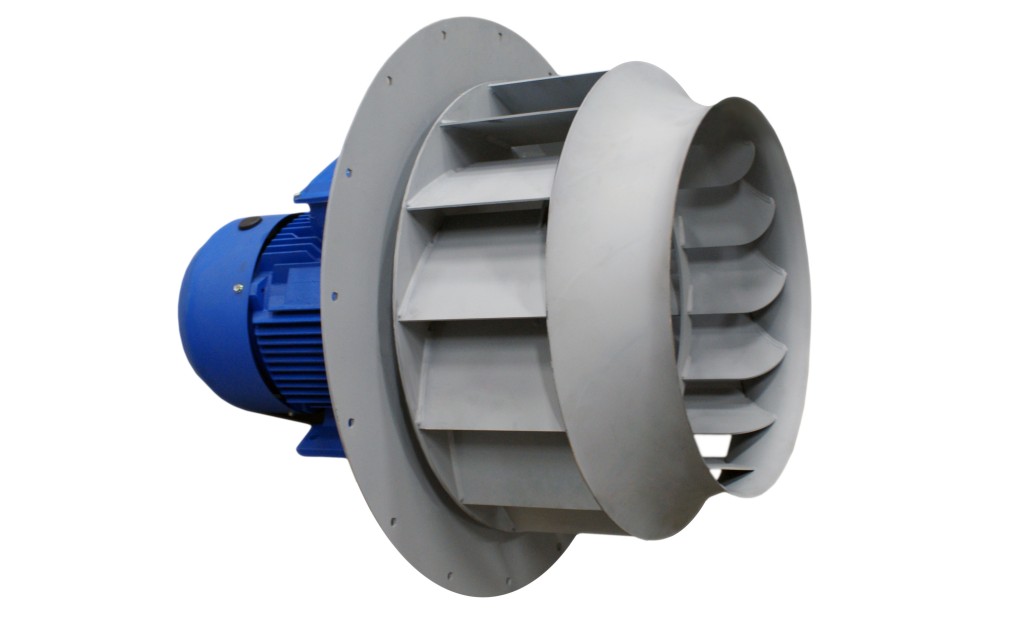Types of Paint Booth Fans – Many other types of fans exist and may be found in the industrial world, but in regards to the automotive refinish market, there are four main types that you will see.
 1. Tube-axial fan (Shown on Left)
1. Tube-axial fan (Shown on Left)
Most industrial paint booths, truck paint booths, and entry level automotive paint booths use the tube-axial fan as the fan of choice for the exhaust side of the airflow. This is mostly due to the low cost of the hardware and low cost of the installation. The fan itself is economic. It needs no additional housing and is simply installed in line with the paint booth or prep station exhaust ductwork. Most applications in the automotive and truck paint booth market use belt-driven tube axial fans however, direct drive versions do exist. Direct drive versions may require an explosion proof motor and are generally not seen in the automotive paint booth industry.
2. Forward Curve Centrifugal Blower (Shown on Right)
A forward curve centrifugal blower or “squirrel cage” is used predominantly in the intake side of any paint booth or in aftermarket air makeup units that can be added to a spray booth after the fact (aftermarket meaning it was not manufactured or designed by the paint booth manufacturer). It is also used in commercial and residential heaters. This type of fan is used almost solely in intake units and not in the exhaust because it is built to handle clean air. A forward curve fan could not support being laden with the paint overspray if it were used in the exhaust side of the paint booth. Eventually, the overspray would cake up enough to diminish performance, throw the fan out of balance, or even break blades off the wheel. The forward curve fan is also preferred for most intake units because it is the quietest of all fans and delivers very powerful airflow for its size and weight. Since the air coming through the intake is delivered right to the paint booth workspace, the sound level produced by the intake fan is conducted right to the worker and noise level is a very important consideration when a paint booth manufacturer is trying to design a comfortable workspace.
3. Backward Inclined Centrifugal Blower
A backward inclined fan is used predominantly in the exhaust of a paint booth or spray application because it is engineered to handle the paint overspray in the air and it can handle greater static pressure. (Think of this like “back pressure” or how hard it is to push the air where it needs to go). Handling higher static pressure in the case of a paint booth generally means it can flow air through heavily soiled filters or through ductwork with a lot of turns.
Within Backward Inclined fans, there are the two sub-types; Dual Inlet Belt Driven Fans & Single Inlet Direct Driven Fans. Both have the same type of blade/wheel construction that can work through heavy overspray and caked filters. They vary simply in terms of where the motor is placed and how the air flow moves through them.
3a. A BELT DRIVEN DUAL INLET (Shown on Left) has a shaft that runs through the wheel. The shaft is accessible on the exterior of the fan housing. Because of this, the manufacturer has the flexibility to design the motor to mount anywhere around the fan. The motor may be either inside or outside the main box or on either the left or the right side since the shaft protrudes on either side of the fan wheel. The motor shaft gets a pulley and so does the fan shaft. They are then connected with belts in order to provide rotation. When the unit is started, air flows into the center of the wheel from both sides (“Dual Inlet”) and the air is then expelled out the mouth of the fan.
3b. A DIRECT DRIVE SINGLE INLET (Shown on Right) has no shaft and simply has a coupling or “hub” on one side of the fan wheel that allows the motor shaft to hook directly into the fan wheel. When the unit is started, air flows into the open side of the wheel and is then expelled out the mouth of the fan. The term “single inlet” comes from the fact that the fan can only draw from one direction because the motor and mounting plate are blocking the other side of the wheel.


